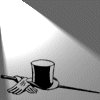Spotlight on Lettering - Mandrake the Magician: Difference between revisions
mNo edit summary |
|||
| Line 3: | Line 3: | ||
|Subject= Lettering | |Subject= Lettering | ||
|}} | |}} | ||
==Early Lettering== | ==Early Lettering== | ||
| Line 44: | Line 43: | ||
<br clear=all> | <br clear=all> | ||
===Early Lettering The Phantom Dailies=== | |||
[[Image:letters-pd-001.png|left|thumb|''letters from the twelve first strips of The Phantom'']] | |||
Before [[Ray Moore]] became the artist on [[The Phantom]] he was an assistant on Mandrake. Comparing the lettering for the first "two weeks" with The Phantom ''(likely done by Ray Moore)'' shows that Ray Moore did not assisted on the lettering in Mandrake. The "M" and "W" looks different, and not infrequently Moore fails to connect the strokes that forms "B" and "R". | |||
<br clear=all> | |||
{{stub}} | {{stub}} | ||
Revision as of 10:40, 12 June 2016

| |
| Subject: | Lettering |
|---|---|
Early Lettering
In 1939 Phil Davis told [1] that he have found some satisfactory assistants:
"- a pen and ink draftsman to whom he sublets part of his pen work" and
"- another part time worker does the lettering."
"- I used to do it all myself," ...
Early Lettering Dailies
The lettering in the first daily story is of varying quality. The lettering in most of the twelve first strips looks like done without a proper use of guidelines and letters and phrases are uneven. Keep in mind that there is a time gap between the last strip in week two and the first strip in week three. The "two first weeks" was Phil Davis' first attempt to create comics, and was made as a sample that Lee Falk would try to sell to KFS (spring 1934).
Gradually, as Phil Davis get more experience with the lettering, the letters changes a bit and becomes a little wider. Several early letters are characteristic:
- Some letters tends to rise up to right like "B", "D", "G", "O" and "P". (the "P" and "D" are similar in Phil Davis' signatur)
- The upper portions of the letters "P" and "R" predominate over the lower portion.
- The right leg of "K" and "R" is away from the left stroke.
- In the middle the "B" often connect the left stroke falling down left.
In the third daily story the letters have changed to:
- The upper portions of the letters "P" and "R" predominate over the lower portion.
- The right leg of "K" and "R" is away from the left stroke.
- The right leg of "R" also move more right and become longer.
Early Lettering Sundays
The lettering at the first Sunday page is even more uneven than the first week of the dailies. Several letter are also different than the early dailies, like: "B", "C", "D", "G", "M", "O", "R" and "Y".
- "M" with slopping sides.
- The right leg of the "R" touches the left stroke.
- "Y" with a diagonal lower portion.
There may be two explanation for the differences in the letters.
- First: perhaps someone other than Phil Davis did the lettering on the first Sunday page.
- Second: perhaps the first Sunday page was made before the first "two weeks" of the dailies.
Looking at how Mandrake's suit is inked gives an other clue, supporting the second option. Mandrake's suit is inked all black in the first five Sunday pages (some exceptions in week 2 and 5), like in the five first weeks of the dailies (some exceptions in week 4 and 5). The letters in the following Sunday pages are close to the first daily story, and from page six the letters is like in the third daily story. Notice also the tail of the speech balloons, last seen in May 1935.
Early Lettering The Phantom Dailies
Before Ray Moore became the artist on The Phantom he was an assistant on Mandrake. Comparing the lettering for the first "two weeks" with The Phantom (likely done by Ray Moore) shows that Ray Moore did not assisted on the lettering in Mandrake. The "M" and "W" looks different, and not infrequently Moore fails to connect the strokes that forms "B" and "R".
|
This article, or section of an article, is very short. You can help MandrakeWiki by expanding it. |
References
- ↑ Marguerite Martyn. "The Man Who Draws Mandrake." St. Louis Post-Dispatch (St. Louis, Missouri) 30 August 1939, p 3D





